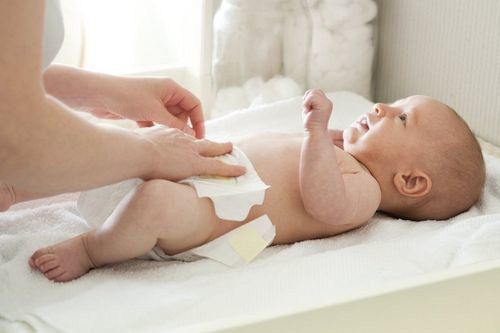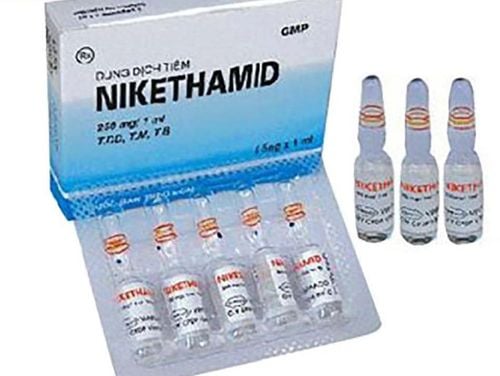This is an automatically translated article.
The article was professionally consulted by Doctor of Pediatrics - Neonatology - Vinmec Nha Trang International General Hospital.Asphyxia due to foreign bodies or food can cause unpredictable complications, even death in young children. Proper treatment as soon as the child has a choking airway will help the child quickly get out of the dangerous situation.
1. Airway obstruction - signs, causes and complications
1.1 What is airway obstruction? What is an airway foreign body? Choking (suffocation) is a condition in which a person cannot breathe or speak because the throat or windpipe is completely blocked. Without timely first aid, the lack of oxygen can cause serious brain damage, even leading to death from asphyxiation.Foreign bodies in the airways are foreign objects that fall into and become lodged in the larynx, trachea, or bronchi. There are two types of foreign bodies, inorganic and organic. A foreign body in the airways is a life-threatening accident that can happen at any age, especially in children. It is estimated that each year about 3,000 patients die from complications of foreign bodies, the rate is especially high in children 1 - 6 years old.
1.2 Signs of airway suffocation due to foreign body The sign of airway asphyxia due to foreign body is quite sudden:
Partial airway obstruction: Victim has difficulty breathing, makes loud noises or sucks air to try to breathe, possibly Hissing sounds around his mouth. The victim may have a dry cough, discomfort, fear due to lack of air, skin and lips become pale, bruised or turned blue; Complete airway obstruction: The victim cannot cough, breathe, or talk. Because of the lack of air, the victim clearly shows symptoms of trying to breathe through the phenomenon of pulling on the chest, the shoulder blades and the sternum. The victim's face turns gray, lips purple-blue. Usually, the victim will use both hands to grasp the throat, very panicked.
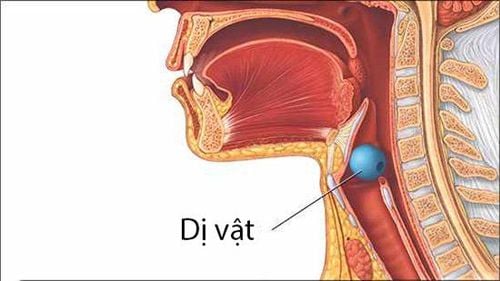
Ngạt thở là tình trạngi không thể thở hoặc nói vì họng hoặc khí quản bị tắc nghẽn hoàn toàn
Patient:
Patient is eating or sucking on a foreign object, due to something that causes the patient to inhale strongly the foreign object following the flow of air falling into the airway . The agents include: crying, laughing, forcing the child to eat by covering his nose, forcing him to take pills; compete to eat; tripping, sneezing,...; Because the child's glottic opening and closing reflex is incomplete; Careless parents in children's eating; Eating habits, bathing in spring water, drinking spring water cause live foreign bodies to enter the airways; Pharyngeal paralysis. Due to medical staff:
Extraction causes teeth to fall, tooth drills fall into the airways; In the emergency, endotracheal intubation pushes the foreign body into the airway; Giving drugs improperly. 1.4 Complications of airway asphyxia due to foreign body Death due to acute asphyxiation; Bronchitis ; pneumonia Pulmonary atelectasis, lung abscess, empyema due to ruptured abscess into the pleura; Pneumothorax, mediastinum due to sharp foreign body puncture the trachea; Bronchiectasis due to long forgotten foreign body; Narrowing of the larynx.
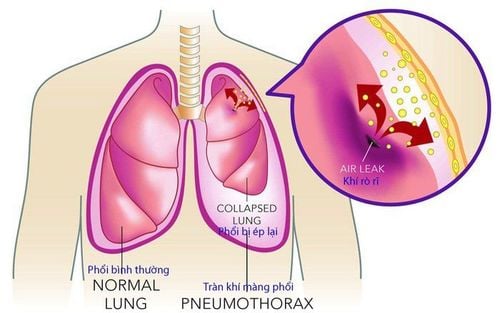
Tràn khí màng phổi là biến chứng của ngạt đường thở do dị vật
2. Instructions on how to give first aid to a child with a blocked airway due to a foreign object
2.1 For adults and children over 1 year of age The management of airway foreign bodies in adults and children over 1 year of age is as follows:Step 1: Ask the victim
The victim cannot speak due to suffocation. If the victim is able to talk, cough, cry or breathe, it means they are having partial airway obstruction. If the victim is still able to respond, reassure the patient, encourage the patient to cough, do not use the back slap maneuver (because it can push the foreign object deep into the airway), closely monitor the patient's condition and Call an ambulance if the airway obstruction does not subside.
If the victim cannot answer, call 911.
If victim is conscious, communicate intent to administer first aid so that they can cooperate.
Step 2: Perform first aid
5 back pats with the heel of your hand:
Use the heel of your hand to pat the victim's back 5 times separately at the position between the shoulder blades; Make sure the back patting is strong enough, each time slapping the back separately to dislodge the foreign body; Assess for improvement after each back pat.
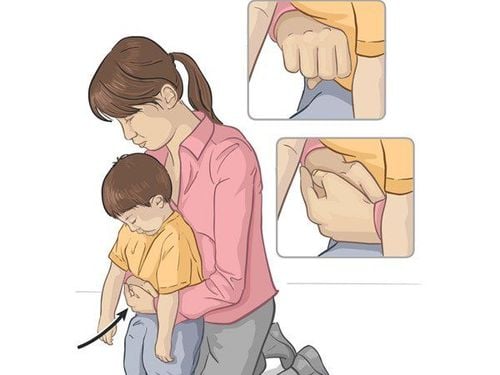
Nghiệm pháp Heimlich
Stand behind the victim; Use both hands to wrap around the victim's waist, below the rib cage; Use the underside of the fist to place near the center of the victim's abdomen (side of the thumb against the abdomen) above the navel and below the nasopharynx (epigastric region); The fist is wrapped in the other hand; Perform separate and definitive abdominal thrusts in an inward and upward direction. Continue until the obstructing foreign body is dislodged – check after each abdominal thrust. Stop manipulation if victim is unconscious. If airway obstruction has not improved, continue alternating 5 back blows and 5 abdominal thrusts until the foreign body is dislodged from the airway.
Step 3: Remove the foreign body
Make sure the foreign body is completely dislodged. If possible, ask the victim to spit out the object. For victims who are too weak or unconscious, first aiders use their fingers to check and remove the foreign body in the mouth.
Check that the victim is breathing normally again. If breathing does not return to normal, examine the mouth and remove the foreign body from the victim's mouth, initiate CPR. Alternate abdominal thrusts, airway checks, and CPR until emergency services arrive.
2.2 For children under 1 year of age Encourage coughing in children with partial airway obstruction:
If the child is coughing or vomiting, it indicates that the child's airway is only partially blocked, the child is not completely hypoxic and needs to be Encourage the child to cough to remove the foreign body.
First aid for children with complete airway obstruction:
If the child cannot cry or make sounds, it means that the child has completely blocked airway, cannot remove the foreign body by coughing, this time first aid for children. Some notes:
Do not try to remove the foreign body by hand because it may cause the foreign body to enter the child's throat deeper, damage the throat or irritate the larynx; Give first aid by placing the child on his or her stomach along the forearm, using the heel of the hand to hit the back between the shoulder blades 5 times continuously, slowly, firmly. Then check to see if the foreign body has been thrown out, the child has cleared the airway (skin is pink again, crying loudly); If after 5 back blows there is still no airway, place the child on his back on a safe surface, use 2 middle fingers, press straight at a 90° angle to the center of the sternum (the large bone in the middle of the baby's chest), level with the line Connect the baby's two nipples. Perform the press 5 times slowly, firmly. Continue to check the child to see if the foreign body has been removed. If a foreign body is found to be expelled, it is still in the mouth, so gently use the little finger to push the foreign body out; Call 911 immediately if the foreign body cannot be removed from the child's airway; While waiting for the emergency, continue to perform 5 back blows, 5 chest compressions alternately until the baby can cry or until the ambulance arrives; If the child is found unconscious, perform CPR.
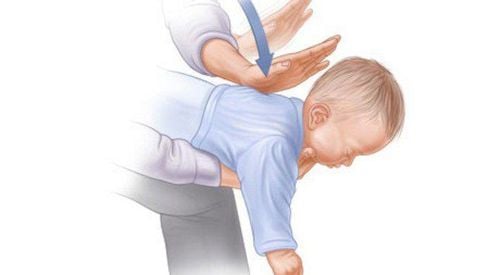
Sơ cứu trẻ dưới 1 tuổi bị tắc nghẽn đường thở hoàn toàn
3. Measures to prevent airway asphyxia due to foreign body in children
Keep balloons, small toys, detachable toys,... out of reach of children; Do not leave buttons, batteries, small furniture, etc. within reach of children; Prevent food choking by always letting your baby sit still when eating, encouraging him to eat slowly, chewing well, and not forcing him to eat because it can cause him to choke. When a child has asphyxiation due to a foreign body, parents need to call an ambulance and immediately follow first aid instructions to help the child push the object out, minimizing the risk of unpredictable complications.As a key area of Vinmec Health system, Pediatrics Department always brings satisfaction to customers and is highly appreciated by industry experts with:
Gathering a team of top doctors and nurses in Pediatrics : consists of leading experts with high professional qualifications (professors, associate professors, doctorates, masters), experienced, worked at major hospitals such as Bach Mai, 108.. Doctors All doctors are well-trained, professional, conscientious, knowledgeable about young psychology. In addition to domestic pediatric specialists, the Department of Pediatrics also has the participation of foreign experts (Japan, Singapore, Australia, USA) who are always pioneers in applying the latest and most effective treatment regimens. . Comprehensive services: In the field of Pediatrics, Vinmec provides a series of continuous medical examination and treatment services from Newborn to Pediatric and Vaccine,... according to international standards to help parents take care of their baby's health from birth to childhood. from birth to adulthood Specialized techniques: Vinmec has successfully deployed many specialized techniques to make the treatment of difficult diseases in Pediatrics more effective: neurosurgery - skull surgery, stem cell transplantation. blood in cancer treatment. Professional care: In addition to understanding children's psychology, Vinmec also pays special attention to the children's play space, helping them to have fun and get used to the hospital's environment, cooperate in treatment, improve the efficiency of medical treatment. To register for examination and treatment with Pediatricians at Vinmec International General Hospital, please click the "Contact Us" button on the website or register for an online examination HERE.
Reference source: Vietnam Institute of Applied Medicine
SEE MORE:
First aid in case of emergency choking The importance of first aid Doctor Vinmec explains 8 common mistakes when giving first aid at home





